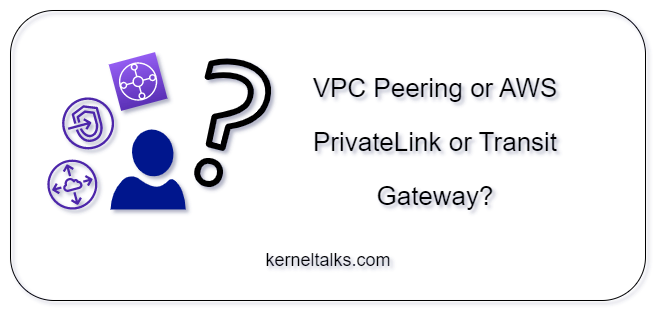In this article, we will compare three different ways to cross-VPC communication: VPC peering, AWS PrivateLink, and Transit Gateway. We’ll also discuss when to use each one and help you choose the best option. It’s important to note that we won’t dive deep into each implementation; instead, we’ll focus on their advantages, limitations, and ideal usage scenarios.

When operating Cloud Native applications, maintaining private and secure communication between applications is crucial. These applications may be distributed across various VPCs, whether within the same account or across different accounts. In such scenarios, we establish cross-VPC communication through the use of VPC peering, AWS PrivateLink, or Transit Gateway.
Let’s look at them one by one.
VPC Peering
It is a networking connection between two VPCs where network traffic can be routed across two VPCs. Read more about VPC peering here. Let’s look at the pros and cons of the VPC peering –
Advantages
- Relatively straightforward to configure. It’s an invite-accept configuration.
- Create network connectivity between two VPCs, resulting in a scalable network connection solution, enabling all resources in one VPC to communicate with resources in the other.
- A simple, secure, and budget-friendly option.
- VPC Peering comes at no additional cost; you are only billed for data transfer costs. The data transfer cost for VPC peering within the same Availability Zone (AZ) is completely free.
Limitations
- Peering VPCs with overlapping CIDRs is not possible.
- Peering is non-transitive.
Ideal usage
- Individual VPC-to-VPC connections.
- A situation that demands full network connectivity with other VPC.
- A use case where a simple and cost-effective solution is expected.
- This approach is not well-suited for handling a large number of VPCs. In such cases, Transit Gateway is the preferred solution. Since mesh networking between a large number of VPCs using peering adds complexity to the architecture.
AWS PrivateLink
It’s an AWS service that enables you to access AWS services over a private network connection, rather than over the public internet. Read more about AWS PrivateLink here.
Advantages
- A selective sharing of services between VPCs. Unlike VPC peering, where all VPC network access is unrestricted, AWS PrivateLink permits only specific services to be accessible across VPC.
- This is a secure solution for private connectivity of services across VPCs or on-premises.
Limitation
- It’s a connectivity option between your VPC and AWS services, not between VPCs. For VPC-to-VPC connectivity, consider VPC peering or Transit Gateway.
- The setup process is complex.
- It necessitates the creation of Network Load Balancers (NLB), Application Load Balancers (ALB), and Gateway endpoints, which introduces additional costs and management overhead.
- Enabling PrivateLink for existing services requires design adjustments, including the incorporation of the above components into the current architecture.
Ideal usage
- It can be valuable in hybrid cloud configurations to make services accessible privately between VPCs and on-premises environments.
- It’s beneficial for accessing AWS’s public services like Amazon DynamoDB and Amazon S3 through AWS’s backbone network, ensuring secure, fast, and reliable connectivity while potentially reducing network costs.
- It’s applicable for creating isolation by selectively exposing specific services to particular VPCs.
Transit Gateway
AWS Transit Gateway is a service that makes network routing easier for your Amazon Virtual Private Clouds (VPCs), on-premises networks, and VPN connections. It helps to simplify and centralize network routing. Read more about Transit Gateway here.
Advantages
- A concrete method to link numerous VPCs, network devices, VPN connections, or an AWS Direct Connect gateway, featuring transitive routing for the simplification of network design.
- Multicast support facilitates effortless distribution of content and data to various endpoints.
- Efficiently manage and control large-scale networking via a single, unified service.
Limitations
- The design becomes more complex and expensive when expanding globally through inter-region Transit Gateway peering.
- VPCs cannot achieve direct internet access as it lack Internet Gateway (IGW) attachment support.
- It incurs charges based on the number of attachments and data processed per gigabyte, potentially making it a costly choice in specific scenarios.
Ideal usage
- It is well-suited for hub-and-spoke architectures, designs that involve a significant number of VPCs, transitive routing needs, and global or multi-region network designs.
- It is designed for scalability and is particularly suitable for continuously expanding environments.
- It’s valuable for efficiently managing network connectivity among a large number of diverse participants.
Which one should I use?
As we’ve discussed, each of these three networking approaches has its specific areas of focus tailored to particular use cases. Consequently, the choice depends entirely on your unique requirements.
VPC Peering is an excellent choice when you need to connect a limited number of VPCs with minimal cost implications and management overhead.
AWS PrivateLink is the right option when you intend to selectively expose services to other VPCs, although it involves additional costs, extra networking components, and the associated management overhead.
Transit Gateway can serve as an alternative to VPC Peering as you scale to a larger number of VPCs, simplifying network management at the expense of some additional costs. It’s also well-suited for connecting various network entities with anticipated scalability.
Share Your Comments & Feedback: